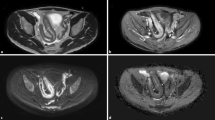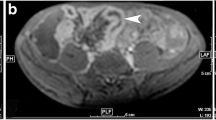Abstract
Purpose
To evaluate the utility of Diffusion-weighted imaging (DWI) and apparent diffusion coefficient (ADC) in assessing treatment response in patients of intestinal tuberculosis (ITB).
Method and materials
MR Enterography (MRE) was done for patients with suspicion of ITB and 19 patients with pre- and post-treatment imaging were included in the analysis. MRE included T1W, T2W, post-contrast T1W, and DWI sequences. DWI was done using b values—0, 400 and 800 s/mm2, and ADC maps were generated. The trace DW images and ADC values were compared before and after therapy. Composite gold standard (clinical, colonoscopic criteria, and biopsy) was used to assess treatment response and to classify into no response, partial response, and complete response.
Results
Thirty-one bowel segments were evaluated at baseline and after treatment in 19 patients. Prior to therapy, restricted diffusion was seen in 29/31 (93.5%) segments. After treatment, patients with either complete or partial response (27/31 segments, 15 patients) showed significant rise in mean ADC values from 1.1 ± 0.37 × 10−3 to 2.1 ± 0.64 × 10−3 mm2/s (p value < 0.05), whereas no significant change was found in mean ADC values of non-responders (4/29 segments in 4 patients) which increased from 1.0 ± 0.1 × 10−3 mm2/s on baseline scan to 1.32 ± 0.2 × 10−3 mm2/s on post-treatment scan (p value = 0.318). An increase in ADC value was found to be a reliable and objective marker of improvement with response to therapy.
Conclusion
ADC values show good correlation with treatment response in ITB and can be used for objectively quantifying it.







Similar content being viewed by others
References
Debi U, Ravisankar V, Prasad KK, Sinha SK, Sharma AK. Abdominal tuberculosis of the gastrointestinal tract: revisited. World J Gastroenterol. 2014;20(40):14831–40.
Amarapurkar DN, Patel ND, Rane PS. Diagnosis of Crohn’s disease in India where tuberculosis is widely prevalent. World J Gastroenterol. 2008;14(5):741–6.
Munot K, Ananthakrishnan AN, Singla V, Benjamin J, Kedia S, Dhingra R, et al. Response to Trial of Antitubercular Therapy in Patients With Ulceroconstrictive Intestinal Disease and an Eventual Diagnosis of Crohn’s Disease. Gastroenterology. 2011;140(5):S-159.
Al-Hawary MM, Zimmermann EM, Hussain HK. MR imaging of the small bowel in Crohn disease. Magn Reson Imaging Clin N Am. 2014;22(1):13–22.
Li X-H, Sun C-H, Mao R, Huang S-Y, Zhang Z-W, Yang X-F, et al. Diffusion-weighted MRI Enables to Accurately Grade Inflammatory Activity in Patients of Ileocolonic Crohn’s Disease: Results from an Observational Study. Inflamm Bowel Dis. 2017;23(2):244–53.
Krishna S, Kalra N, Singh P, Kochhar R, Gupta R, Singh R, et al. Small-Bowel Tuberculosis: A Comparative Study of MR Enterography and Small-Bowel Follow-Through. AJR Am J Roentgenol. 2016;207(3):571–7.
Oto A, Zhu F, Kulkarni K, Karczmar GS, Turner JR, Rubin D. Evaluation of Diffusion-weighted MR Imaging for Detection of Bowel Inflammation in Patients with Crohn’s Disease. Acad Radiol. 2009;16(5):597–603.
Paustian F. Tuberculosis of the intestine. In: Bockus HL, ed. Bockus Gastroenterology. 5 ed. Philadelphia: Saunders; 1995. p. 3304.
Logan VS. Anorectal tuberculosis. Proc R Soc Med [Internet]. 1969;62(12):1227–30.
Park SH. DWI at MR Enterography for Evaluating Bowel Inflammation in Crohn Disease. American Journal of Roentgenology [Internet]. 2016;207(1):40–8.
Tielbeek JAW, Makanyanga JC, Bipat S, Pendsé DA, Nio CY, Vos FM, et al. Grading Crohn disease activity with MRI: interobserver variability of MRI features, MRI scoring of severity, and correlation with Crohn disease endoscopic index of severity. AJR Am J Roentgenol. 2013;201(6):1220–8.
Huh J, Kim KJ, Park SH, Park SH, Yang S-K, Ye BD, et al. Diffusion-Weighted MR Enterography to Monitor Bowel Inflammation after Medical Therapy in Crohn’s Disease: A Prospective Longitudinal Study. Korean J Radiol. 2017;18(1):162–72.
Bhatnagar G, Dikaios N, Prezzi D, Vega R, Halligan S, Taylor SA. Changes in dynamic contrast-enhanced pharmacokinetic and diffusion-weighted imaging parameters reflect response to anti-TNF therapy in Crohn’s disease. Br J Radiol. 2015;88(1055):20150547
Ninivaggi V, Missere M, Restaino G, Gangemi E, Di Matteo M, Pierro A, et al. MR-enterography with diffusion weighted imaging: ADC values in normal and pathological bowel loops, a possible threshold ADC value to differentiate active from inactive Crohn’s disease. Eur Rev Med Pharmacol Sci. 2016;20(21):4540–6.
Pendsé DA, Makanyanga JC, Plumb AA, Bhatnagar G, Atkinson D, Rodriguez-Justo M, et al. Diffusion-weighted imaging for evaluating inflammatory activity in Crohn’s disease: comparison with histopathology, conventional MRI activity scores, and faecal calprotectin. Abdom Radiol (NY). 2017;42(1):115–23.
Qi F, Jun S, Qi QY, Chen PJ, Chuan GX, Jiong Z, et al. Utility of the diffusion-weighted imaging for activity evaluation in Crohn’s disease patients underwent magnetic resonance enterography. BMC Gastroenterol. 2015;15:12.
Author information
Authors and Affiliations
Corresponding author
Additional information
Publisher's Note
Springer Nature remains neutral with regard to jurisdictional claims in published maps and institutional affiliations.
Rights and permissions
About this article
Cite this article
Mathur, P., Sharma, R., Kandasamy, D. et al. Can ADC be used as a surrogate marker of response to therapy in intestinal tuberculosis?. Abdom Radiol 44, 3006–3018 (2019). https://doi.org/10.1007/s00261-019-02090-4
Published:
Issue Date:
DOI: https://doi.org/10.1007/s00261-019-02090-4




